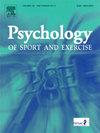The association and impact of psychological and social factors on physical activity levels amongst women in the Australian WATCH longitudinal study
IF 3.1
2区 心理学
Q2 HOSPITALITY, LEISURE, SPORT & TOURISM
引用次数: 0
Abstract
Introduction
Regular physical activity is important for physical and mental health. Despite the benefits, over 30% of the global population do not meet the World Health Organisation (WHO) physical activity guidelines, with the risk greater for women, especially during reproductive years, compared to men. However, women of this age face many barriers to participation and there are significant gaps in our understanding of the impact of psychological and social adversity on participation levels. This study aimed to identify adversity factors associated with physical inactivity or reduced activity.
Methods
Data from 623 women in the WATCH prospective cohort study, a representative sample of women recruited during the antenatal phase, including half from refugee backgrounds, were analyzed to assess the association between prior theoretically supported adversities (e.g., financial stress, living difficulties, intimate partner violence, refugee status and mental health issues) and current physical activity levels. Physical activity was assessed via self-report, using the Physical Activity Vital Sign. A categorical indicator was constructed to describe participants average activity per week based on WHO physical activity and muscle strengthening guidelines; inactive, below recommendation and at or exceeds recommendation. Binary multinomial logistic regression analyses were conducted to examine the crude and demographically adjusted association between each variable and physical activity with. At or exceeds recommendation as the reference group.
Results
N = 122 (20 %) of the total sample reported no physical activity (0 min) during the previous week. Meanwhile, n = 445 (71 %) engaged in some physical activity but did not meet the recommended guidelines, and n = 56 (9 %) met the guidelines. The odds of being inactive were significantly higher for women from refugee backgrounds OR = 5.79, 95 % CI 2.70 to 12.41, p < .001. In addition, who who have experienced previous trauma, living difficulties, or mental health symptoms had significantly higher odds of being inactive.
Conclusion
High rates of physical inactivity among reproductive-age women were observed. Interventions aimed at increasing physical activity should consider adversity factors identified in this study which impact participation levels, including refugee status, trauma exposure, intimate partner violence, living difficulties, and mental disorder symtoms in their design and implementation.
澳大利亚 WATCH 纵向研究》中妇女的心理和社会因素与体育活动水平的关系及影响。
引言经常参加体育锻炼对身心健康非常重要。尽管体育锻炼好处多多,但全球仍有 30% 以上的人口未达到世界卫生组织(WHO)的体育锻炼指导标准,与男性相比,女性的风险更大,尤其是在育龄期。然而,这个年龄段的女性在参与体育锻炼方面面临许多障碍,而且我们对心理和社会逆境对参与体育锻炼水平的影响的认识还存在很大差距。本研究旨在确定与缺乏运动或运动量减少有关的逆境因素:分析了WATCH前瞻性队列研究中623名妇女的数据,该研究对产前阶段招募的妇女进行了代表性抽样调查,其中半数妇女来自难民背景,研究旨在评估之前理论上支持的逆境(如经济压力、生活困难、亲密伴侣暴力、难民身份和心理健康问题)与当前体育活动水平之间的关联。体力活动通过自我报告进行评估,使用的是体力活动生命体征。根据世界卫生组织的体力活动和肌肉强化指南,对参与者每周平均活动量进行了分类;不活跃、低于建议水平和达到或超过建议水平。以 "达到或超过推荐值 "为参照组,对每个变量与体力活动之间的粗略关联和人口统计学调整关联进行了二元多项式逻辑回归分析:在所有样本中,有 122 人(20%)表示在上周没有进行体育锻炼(0 分钟)。同时,有 445 人(71%)参加了一些体育活动,但未达到推荐标准,有 56 人(9%)达到了推荐标准。来自难民背景的妇女缺乏运动的几率明显更高,OR= 5.79,95% CI 2.70 至 12.41,p结论:育龄妇女中缺乏体育活动的比例很高。旨在增加体育锻炼的干预措施在设计和实施过程中应考虑到本研究中发现的影响参与水平的不利因素,包括难民身份、遭受创伤、生活质量差、生活困难、残疾和精神疾病。
本文章由计算机程序翻译,如有差异,请以英文原文为准。
求助全文
约1分钟内获得全文
求助全文
来源期刊
CiteScore
6.40
自引率
5.90%
发文量
172
审稿时长
69 days
期刊介绍:
Psychology of Sport and Exercise is an international forum for scholarly reports in the psychology of sport and exercise, broadly defined. The journal is open to the use of diverse methodological approaches. Manuscripts that will be considered for publication will present results from high quality empirical research, systematic reviews, meta-analyses, commentaries concerning already published PSE papers or topics of general interest for PSE readers, protocol papers for trials, and reports of professional practice (which will need to demonstrate academic rigour and go beyond mere description). The CONSORT guidelines consort-statement need to be followed for protocol papers for trials; authors should present a flow diagramme and attach with their cover letter the CONSORT checklist. For meta-analysis, the PRISMA prisma-statement guidelines should be followed; authors should present a flow diagramme and attach with their cover letter the PRISMA checklist. For systematic reviews it is recommended that the PRISMA guidelines are followed, although it is not compulsory. Authors interested in submitting replications of published studies need to contact the Editors-in-Chief before they start their replication. We are not interested in manuscripts that aim to test the psychometric properties of an existing scale from English to another language, unless new validation methods are used which address previously unanswered research questions.

 求助内容:
求助内容: 应助结果提醒方式:
应助结果提醒方式:


